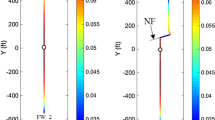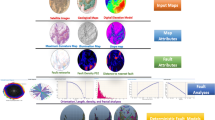Abstract
Characterization of discrete fracture networks is necessary for unconventional reservoir development, as they control the flow of fluids toward the hydraulically fractured well. Interpretation of microseismic data provides information about the discrete fracture network in the vicinity of a well. While microseismic interpretation is currently based on plotting the swarm of microseismic events, the inference of fracture-related information from such data is likely to be non-unique. To address this non-uniqueness, the presented workflow involves applying a forward model that produces a synthetic seismogram corresponding to a suite of natural fractured reservoir models. The characteristics of the generated seismograms can be compared with the observed seismogram to determine the suite of fracture models that best reflect the observed seismic signature. The available full physics models are computationally expensive and cannot be applied within this framework. Hence, a proxy model is developed that is computationally inexpensive so that it can be applied on a large ensemble of models within the Bayesian model selection framework described above. Seismic wave propagation during a fracturing job involves many intermediate processes such as diffraction and reflection. As analytical solutions for most of these processes exist, a coupled analytical model is proposed. Firstly, a hydraulic fracture propagation model is coupled with a model for the interaction between a hydraulic fracture and a natural fracture. This interaction results in slip events along natural fractures that in turn can trigger a seismic event. With knowledge of the location of the slip event, a Green’s function solution is applied to model the propagation of the seismic wave. Using the results from the slip event and Green’s function, a synthetic seismogram is generated. Finally, the seismic signature from multiple slip events along several natural fractures is combined. Validation of individual elements of the coupled proxy model to experiments is shown. A comparison of the developed proxy model with more computationally expensive models is also performed.





















Similar content being viewed by others
References
Adachi J, Siebrits E, Peirce A, Desroches J (2007) Computer simulation of hydraulic fractures. Int J Rock Mech Min Sci 44(5):739–757
Aki K, Richards PG (2002) Quantitative seismology. University Science Books, Sausalito
Blanton TL (1982) An experimental study of interaction between hydraulically induced and pre-existing fractures. In: SPE unconventional gas recovery symposium, Society of Petroleum Engineers
Bouchon M (2003) A review of the discrete wavenumber method. Pure Appl Geophys 160(3):445–465
Bunger AP, Detournay E, Garagash DI (2005) Toughness-dominated hydraulic fracture with leak-off. Int J Fract 134(2):175–190
Detournay E, Garagash D (2003) The near-tip region of a fluid-driven fracture propagating in a permeable elastic solid. J Fluid Mech 494:1–32
Detournay E, Peirce A, Bunger A (2007) Viscosity-dominated hydraulic fractures. In: 1st Canada-US rock mechanics symposium, American Rock Mechanics Association
Economides MJ, Nolte KG (1989) Reservoir stimulation, vol 2. Prentice Hall, Englewood Cliffs
Garagash DI (2006) Propagation of a plane-strain hydraulic fracture with a fluid lag: early-time solution. Int J Solids Struct 43(18):5811–5835
Geertsma J, De Klerk F (1969) A rapid method of predicting width and extent of hydraulically induced fractures. J Pet Technol 21(12):1–571
Gu H, Weng X, Lund JB, Mack MG, Ganguly U, Suarez-Rivera R (2012) Hydraulic fracture crossing natural fracture at nonorthogonal angles: a criterion and its validation. SPE Prod Oper 27(01):20–26
Gudmundsson A (2011) Rock fractures in geological processes. Cambridge University Press, Cambridge
Guglielmi Y, Cappa F, Avouac JP, Henry P, Elsworth D (2015) Seismicity triggered by fluid injection-induced aseismic slip. Science 348(6240):1224–1226
Herrmann RB (2013) Computer programs in seismology: an evolving tool for instruction and research. Seismol Res Lett 84:1081–1088
Huang W, Wang R, Li H, Chen Y (2017) Unveiling the signals from extremely noisy microseismic data for high-resolution hydraulic fracturing monitoring. Sci Rep 7(1):11996
Khristianovic S, Zheltov Y (1955) Formation of vertical fractures by means of highly viscous liquid. In: 4th world petroleum congress, World Petroleum Congress
Mangrove (2017) Petrel simulation suite. Schlumberger, Houston
Nordgren R (1972) Propagation of a vertical hydraulic fracture. Soc Pet Eng J 12(04):306–314
Perkins T, Kern L (1961) Widths of hydraulic fractures. J Pet Technol 13(09):937–949
Potluri N, Zhu D, Hill A D (2005) The effect of natural fractures on hydraulic fracture propagation. In: SPE European formation damage conference, society of petroleum engineers
Renshaw C, Pollard D (1995) An experimentally verified criterion for propagation across unbounded frictional interfaces in brittle, linear elastic materials. Int J Rock Mech Min Sci Geomech Abstr 32:237–249
Sneddon IN (1946) The distribution of stress in the neighbourhood of a crack in an elastic solid. Proc R Soc Lond A 187(1009):229–260
Tanioka Y, Ruff LJ (1997) Source time functions. Seismol Res Lett 68(3):386–400
Warpinski N, Teufel L (1987) Influence of geologic discontinuities on hydraulic fracture propagation (includes associated papers 17011 and 17074). J Pet Technol 39(02):209–220
Warpinski N, Abou-Sayed I, Moschovidis Z, Parker C (1993) Hydraulic fracture model comparison study: complete results. Technical report, Sandia National Labs., Albuquerque, NM (United States); Gas Research Inst., Chicago, IL (United States)
Acknowledgements
Support from NSF in the form of Grant UP60D60 is gratefully acknowledged. Funding was provided by the Directorate for Computer and Information Science and Engineering.
Author information
Authors and Affiliations
Corresponding author
Rights and permissions
About this article
Cite this article
Singh, M., Srinivasan, S. Development of Proxy Model for Hydraulic Fracturing and Seismic Wave Propagation Processes. Math Geosci 52, 81–110 (2020). https://doi.org/10.1007/s11004-019-09830-8
Received:
Accepted:
Published:
Issue Date:
DOI: https://doi.org/10.1007/s11004-019-09830-8




